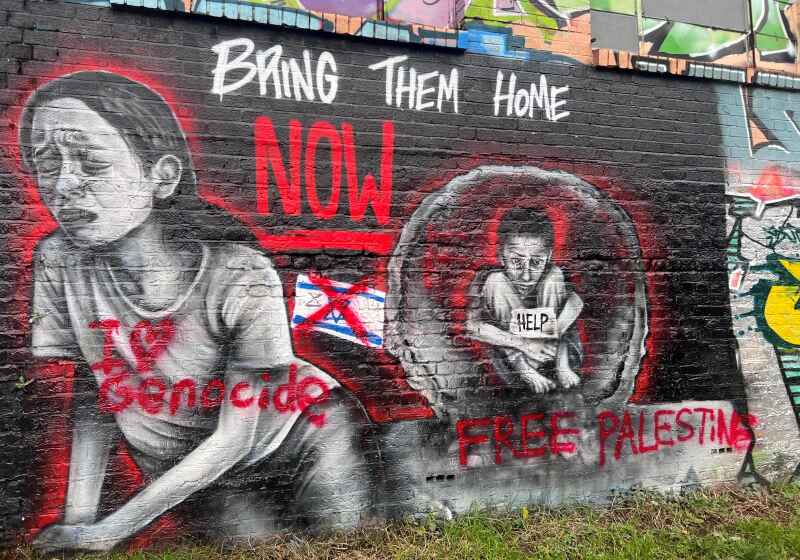CST Blog
The acceptable face of extremism
15 January 2024
In April 2003, two British men in their 20s, one from Derby in the East Midlands and the other from Hounslow, west London, entered the West Bank via the border with Jordan. They travelled through the West Bank to enter Israel, eventually making their way to a Tel Aviv hostel where they stayed for the night. The following day, they departed for Gaza, using their British passports to enter with relative ease.
Once in Gaza, the two Brits met with Hamas, the Islamist Palestinian terrorist group. It was at this meeting, in an apartment in Gaza, that the two men posed in front of a Hamas flag, both dressed in full combat fatigues, adorned with Hamas headbands, holding AK47s and holding a Quran between them. This was also where the pair collected their improvised explosive devices (IEDs) and recorded their martyrdom message, stating on video that, “we have come from Britain to commit an act of Jihad for the sake of Allah”.
The pair then made their way back into Israel to their Tel Aviv hostel. In the early hours of 30 April 2003, Asif Hanif, over 2,000 miles from his Hounslow home, detonated his device at the Mike’s Place bar in Tel Aviv. The explosion killed three Israelis and injured over 50 others. Omar Khan Sharif, his accomplice, did not detonate, his IED failing. Sharif was found dead nearly two weeks later, floating just offshore the Tel Aviv beach. They were among the earliest cases of British suicide bombers.
The case of the Mike’s Place bombers now seems a distant memory. We have become inoculated to the phenomenon of Islamist terrorism, suicide bombers and foreign fighters. But the story of Omar Khan Sharif and Asif Hanif is as instructive as ever, especially in the wake of the 7th October Hamas massacre. Both Hanif and Khan’s radicalisation journey started and developed in the UK. Both had links to Hizb ut-Tahrir and its more extreme offshoot, Al-Muhajiroun. The same Hizb ut-Tahrir that has been openly calling for ‘jihad’ at their protests on the streets of London, and calling on “Muslim armies” to invade and attack Israel. Hanif and Khan were both motivated by an extreme Islamist ideology, channelled through deep layers of anti-Israel hate that ultimately found an outlet in an act of terrorism.
Whilst the actuality and perpetration of violent terrorism is hard for many to stomach, it still seems that is less the case when the victims are Israeli Jews. The key to this is simple, just a little bit of marketing and PR spin. First, don’t call it terrorism; resistance is much more palatable. Resistance evokes images of noble warriors fighting for a just cause. Next, don’t label the dead as victims; they’re simply occupiers, or colonisers – this makes it much easier to stomach when they’re being murdered. The result is a much more acceptable, sanitised form of violent extremism, that even your local far-left activist group can get behind. This results in providing a more widely accepted and legitimised form of violent extremism that will ultimately draw in disenfranchised, angry Brits.
Since 7th October, this more digestible brand of extremism has become widespread. From university campuses to the streets of Western capitals and the digital sphere, we’ve become accustomed to this simmering support for, and excusal of, terrorism. A cursory look on Twitter will find numerous accounts proudly displaying an upside-down red triangle emoji, drawn from Hamas’ use of the symbol in footage they release of their attacks on the Israeli military. Many seem to clearly forget that Hamas are designated as a terrorist group by the UK, US, EU, Canada, Australia, and others, including multiple Arab states. In the UK, expressing support for or glorifying Hamas is a terrorist offence that carries with it the risk of arrest, charge and imprisonment. Indeed, many people in the UK already have started to see the consequences of allegedly breaking terrorism legislation for this exact reason.
Despite this, we continue to see widespread apologism and legitimising in the UK of Hamas’ actions. A number of influential Islamist blogs, clearly careful not to overstep the bounds of terrorism legislation, talk in glowing terms about “the resistance”, often stating that they have to choose their words carefully. Legally, it’s a wise move, but fundamentally it reveals their true attitudes.
The harsh reality of all of this is deeply concerning, not only in the massive spike in global antisemitism, but the potential for this to be followed by a new wave of jihadist terrorism across the West. Terrorism does not simply appear out of thin air: it needs to be cultivated, nurtured and built on a larger foundation of unchecked extremism. The fear is that these foundations are currently being built. Nearly two years after the Mike’s Place attack in Tel Aviv, an associate of Omar Khan Sharif, Mohamed Siddique Khan, led a cell of four British Islamists in a coordinated series of suicide attacks on the London transport system, the attacks we know as 7/7. If we collectively fail to deal with the extremism that is currently taking hold, we risk once again the violent consequences in the coming years, against both Jews and non-Jews alike.


